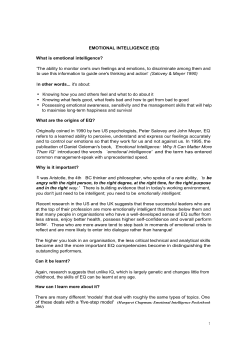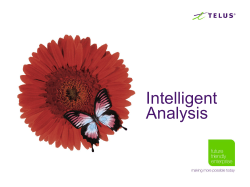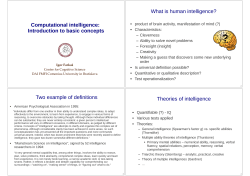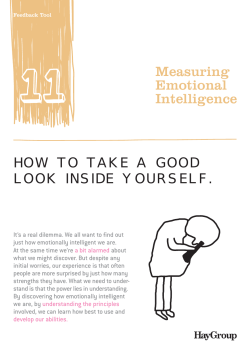
Artificial Intelligence Toolbox Part 1: How to find solutions Myra Wilson e-mail
Artificial Intelligence Toolbox Part 1: How to find solutions Myra Wilson e-mail mxw@aber.ac.uk Aberystwyth University Commitment ● 18 lectures ● 6 hours practical ● ● Rest of time spent on background reading and assignment (76 hours!) Assessment: – Exam 70% – Assignment 30% Course Content ● Introduction - 2 lectures – mxw ● Search – 6 lectures – mxw ● ● ● Evolutionary Computation for Search and Optimisation – 3 lectures – rkj Clustering – 4 lectures – rjk Case-based reasoning and k-nearest neighbour – 3 lectures – rkj What you need to do.... ● ● ● ● Attend lectures – slides are not enough. They are only pointers to the subject Do the practicals – there may be exam questions which these help with Read the books – buy, borrow... many AI books in the library. Read around the subject Access the web – lots of stuff out there Book List ● ● ● ● Russell,S. and Norvig,P. - Artificial Intelligence : a modern approach, 3rd edn, Prentice Hall, 2010. ISBN 0-13-207148-7 Cawsey,A. - The essence of artificial intelligence, Prentice Hall, 1998. Ginsberg,M. - Essentials of artificial intelligence, Morgan Kaufmann, 1993. Coppin,B. - Artificial Intelligence Illuminated, Jones and Bartlett Publishers, 2004. ISBN 0-76373230-3 What is Artificial Intelligence? ● Understand intelligent entities ● Build intelligent entities ● Study constructed intelligent entities Intelligent Systems How is it possible for animal/electrical brains to – Perceive? – Understand? – Predict? – Manipulate? It can be done......... We have the proof! ● Computers and robots can be used as tools to test theories What is Artificial Intelligence? ● ● AI is often burdened with over-promising and grandiosity The gap between AI engineering and AI as a model of intelligence is so large that trying to bridge it almost inevitably leads to assertions that later prove embarrasing. McCarthy said AI was “the science and engineering of making intelligent machines” AI – Hamid Ekbia ● Artificial Intelligence seeks to do three things at the same time: – as an engineering practice, AI seeks to build precise working systems; – as a scientific practice, it seeks to explain the human mind and human behaviour; – as a discursive practice, it seeks to use psyychological terms (derived from its scientific practive) to describe what its artifacts (built through the engineering practice) do. What is Artificial Intelligence? 1. ``[The automation of] activities that we associate with human thinking, activities such as decision-making, problem solving, learning...'' (Bellman, 1978). 2. ``The study of the computations that make it possible to perceive, reason, and act'' (Winston, 1992). 3. ``The study of how to make computers do things at which, at the moment, people are better'' (Rich and Knight, 1991). 4. ``The branch of computer science that is concerned with the automation of intelligent behaviour'' (Luger and Stubblefield, 1993). Definitions of AI Better understanding of human/animal intelligence Emulate and model human/animal behaviour 1. Think like humans 3. Act like humans 2. Think rationally 4. Act rationally Develop inspired techniques which lead to smarter programs and machines. Optimise performance. Foundations ● Philosophy ● Mathematics ● Psychology ● Computer Engineering ● Linguistics ● Biology Alan Turing – Turing Test ● See http://www.turing.org.uk/turing/ ● See also http://en.wikipedia.org/wiki/Turing_test ● Proposed by Alan Turing (1950) to provide a satisfactory operational definition of intelligence The Turing Test Turing Test A computer passes the test if a human interrogator, after posing written questions, cannot tell if the response is from a human or a computer To pass the Turing Test? ● natural language processing ● knowledge representation ● automated reasoning ● machine learning See chatterboxes such as Eliza, Alice etc – http://www.dmoz.org/Computers/Artificial_Intelligence/ Natural_Language/Chatterbots/ The Turing Test ● ● Assumes that intelligence is defined by human-like reasoning and communication Is this the case? The Chinese Room ● ● ● Searle argued that behaving intelligently was not enough (1980's) He devised a thought experiment called the “Chinese Room” http://www.iep.utm.edu/chineser/ What was the Chinese Room? ● ● ● ● You have a rule book that allows you to look up Chinese sentences although you do not speak Chinese The book tells you how to reply to them in Chinese You can then behave in an apparently intelligent way copying replies onto stacks of paper He claimed that although they appeared intelligent, computers would be using the equivalent of a rule book – the rule book and stacks of paper, just being paper, do not understand Chinese What did this say? ● ● From the outside, it looks like the computer is “intelligent” Running programs does not necessarily generate understanding – “Weak AI” claims computers just simulate thought their understanding is not real ● machines just act as if they could think “Strong AI” claims that machines are actually thinking ● – ● ● Classics Games and AI – Noughts and Crosses – Chess – Deep Blue 1997 – Connect 4, Othello, Backgammon, Scrabble, Bridge..... Current – RPG/Adventure – Strategy/Tactical/Combat – Racing – Artificial Life (Creatures, Spore) What AI do they use? ● Pathfinding/Search ● Genetics ● A-life ● Neural Nets ● Fuzzy Logics ● State Machines (condition, event, action) ● Agents..... AI and Games “In the next 20 years, AI is going to be what differentiates one game from another” – Finite State machines used to control character behaviour – A* used to plan paths (very common) Game Techniques Given the state of the world, what do I do next? ● Already in games: – ● Finite State machines, decision trees, rule based systems, neural networks, fuzzy logic In the academic world (too slow for real world) – Complex planning, logic programming, genetic algorithms, Bayes nets Challenges ● Must be smart but purposely flawed ● No unintended weaknesses ● Must perform in real time (CPU) ● Configurable by designers ● Amount and type of AI for games can vary AI Case Study - Creatures What was “Creatures”? ● Computer game published in 1996 by Mindscape ● Creator Steve Grand ● http://www.gamewaredevelopment.co.uk/creatures_index.php ● http://en.wikipedia.org/wiki/Creatures_(artificial_life_program) ● Based on a creature called a “Norn” ● At one point, about 5 million norns worldwide! ● Intended as “virtual pets” ● Inspired by animal biology The norn world Norns ● Composed of neurons, genes, biochemicals etc ● The “gene” dictates how an organism is made ● ● ● ● The behaviour emerges from the interaction of the parts rather than explicit programming Norns can learn about their environment Norns can form relationships and produce offspring which inherit structures from their parents They can become ill How did they do this? ● ● ● Each norn has a neural network responsible for sensory-motor coordination and motor control “artificial biochemistry” which models a simple energy metabolism “hormonal” system which interacts with the neural net to model neuronal activity and development ● Hebbian learning mechanism allows adaptation ● Genetic encoding allows evolution Creatures ● Interactive entertainment environment ● Created synthetic biological agents ● Sufficiently life-like to sell well :-) ● Observer's tendency to anthropomorphism! ● Approx 320 interacting genes ● Engaged public with concept of Artifical Life AI Problems ● ● ● Formal tasks – playing chess or card games, solving puzzles, mathematical or logic problems. Expert tasks – medical diagnosis, engineering, scheduling, computer hardware design. Mundane tasks – everyday speech, written language, perception, walking, handling. How do we solve them? That's what this course is all about! – Search – Evolutionary Computation – Clustering – Case based reasoning and k-nearest neighbour Summary ● AI takes its inspiration from many different disciplines ● Acting and thinking, human and machine ● Turing test ● Games
© Copyright 2025





















